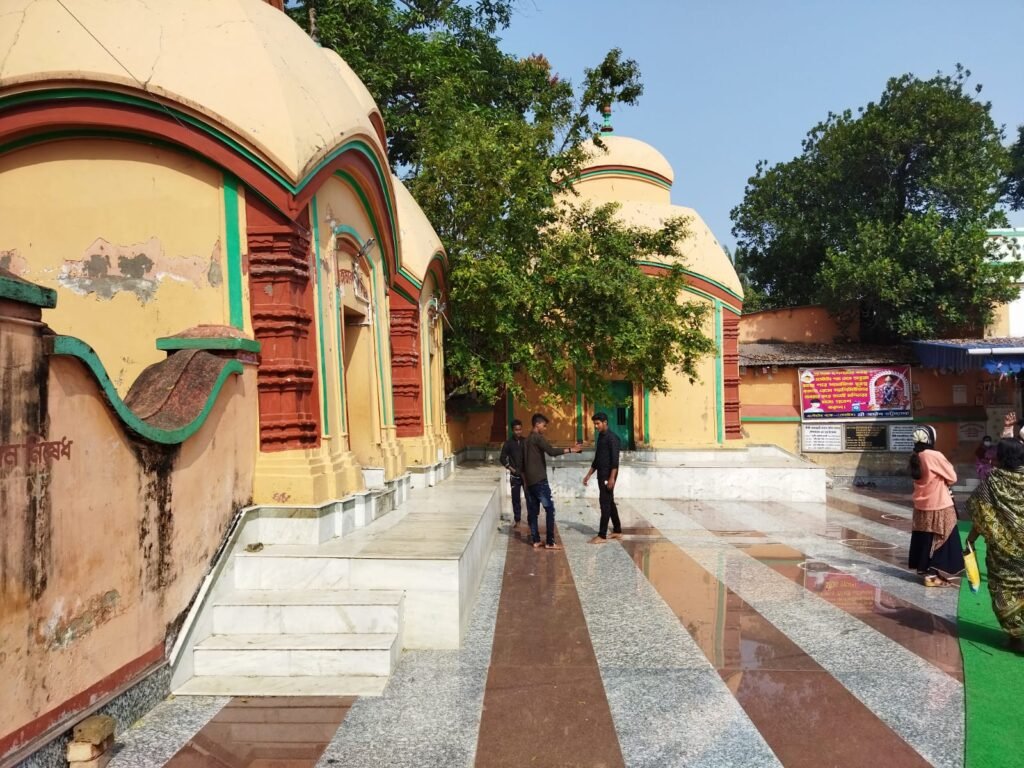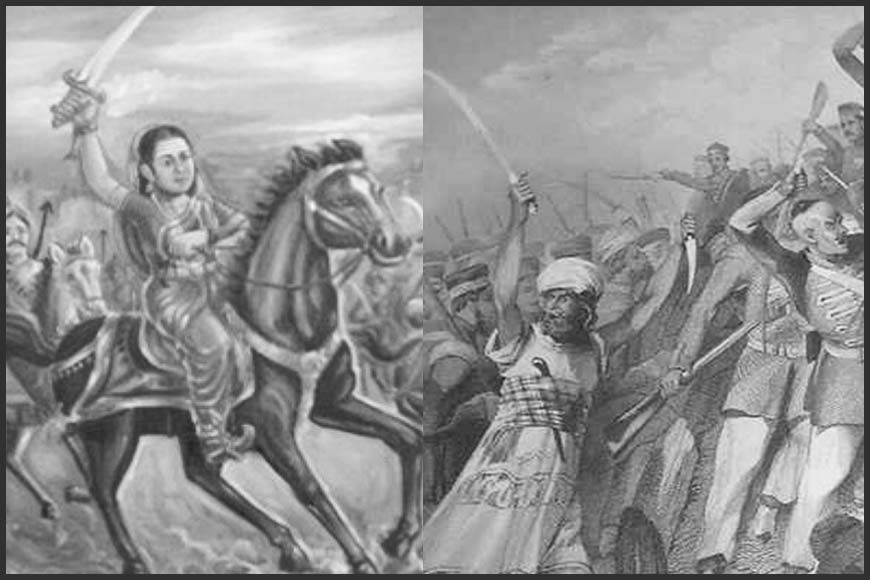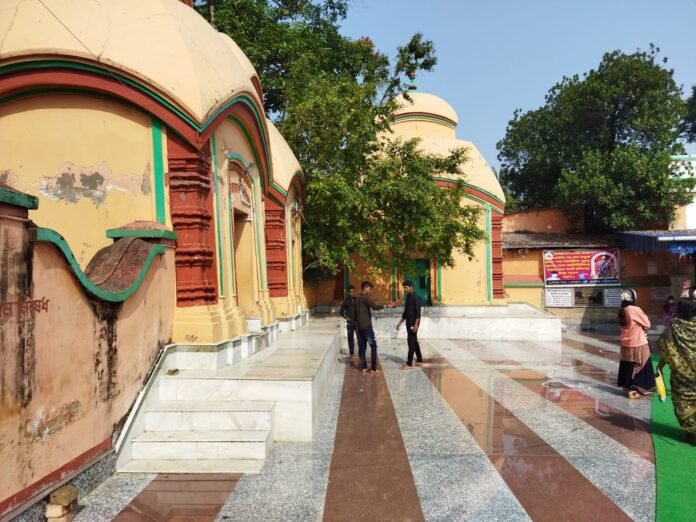15 December 2021 : Over to Rajbalhat
Prelude:
There has been a resurgence of Covid-19 in my home state Bengal. The ongoing Covid-19 restriction has been extended to January 31. So my short tour to write my travel stories for the digital magazine has come to a halt for the past 3 weeks, albeit temporarily. But it now comes to mind that I have a pending story to write upon, based on my visit to Rajbllavi Mandir a month ago.
Introduction
The temple is located in the village Rajbalhat under the Jangipur block in the Hooghly district. It is an iconic temple dating to 1240 AD.
Route to Rajbalhat
For going to Rajbalhat from my home town Chandannagar :
1Take Delhi road first.
2. Cross Dankuni. Follow Ahilya Bai Road.
3. If you are coming from the other side, i.e., Kolkata, Howrah, etc., then after crossing Vivekananda Shetu, follow Kolkata Bombay road to reach Dankuni and then follow Ahilya Bai road.
4. Reach Gojar Mor, and take a left by lane, get past Aatpur to reach village Rajbulhat
5. If you prefer the rail route, take any Tarkeswar or Arambagh bound local train from Howrah station and get down at Haripal station. Then, catch an auto or Toto for Rajbalhat.
Journey to Rajbalhat
Well, on the fine morning of 15th of last December, son Saikat and I reached Rajbalavi Mandir (Rajbalhat) in our car while enjoying the sight of a vast paddy field alongside the highway during our journey via Singur and Kolkata-Arambagh state highway no.2. Instead of the conventional route, we preferred a long road to enjoy nature.
Rajbalhat:Description of Rajballavi temple
If you enter through the temple’s main gate, you will see a ‘Nat Mandir’ at the center of the temple premises. It is surrounded by four Shiva temples, i.e., Kombrokeswar, Someswar, Baneswar, Rajrajeswar & Nandeswar. Besides, there is a pond near the temple.
The temple was very crowded during the winter season. There are lots of temporary shops nearby. It seemed as if the fair was going on. Weaved saris (Tater Sari) are being sold here to dedicate to mother Goddess Rajaballavi’.
There is a community feast every day in which more than 1000 devotees eat here called Anna Bhog. Puja starts at 9:30 in the morning. At eleven o’clock in the morning, Goddess Rajballavi’ is worshiped. In addition, four more Shiva lingas are regularly worshiped. After the evening, the mother Goddess bed fitted with a mosquito net is made ready. A hubble-bubble (hookah) filled with tobacco is also kept beside the bed. Mother Rajballavi would now take a rest. The temple door closes after this till the following day’s morning.
Mother Rajballavi is 6 feet in height and is white in color, and her left leg is placed on the Head of Seated Birupakha Mahadev, and her right leg rests on the chest of Mahakal Bhairav. The right-hand holds a dagger, while the left has a sindoor case. The temple holds an attraction for devotees from the surrounding and far-flung places for its fervor and gaiety.
The Goddess accepts immolation in everyday food with tiny shrimp (in Bengali, Ghusho Chingri). Also, the sacrifice of goats is part of regular worship rituals, and buffaloes are offered every year on the day of Maha Navami of Durga Puja.
Earlier, in keeping with tradition, donating animal blood in a container to please the Goddess was a practice. Still, now as an alternative, Mass karai(pulses), honey, ginger, etc… are offered.
But frankly speaking, unlike my recent visit to other temples like Hanseswari temple in Bansberia or temples at Janai Baksha or Rajbari in Baidyapur and Janai-Baksha, here I am not impressed with the architecture of temple design. The ancient temple here lost its originality following its renovation and structural design several times. Although, the Nahabat Khana at the entrance is original.

While wandering in the temple and outside, I heard Nirmal Saha Choudhary, a member of the temple priest family. narrates the temple’s history. His father author Nimai Saha Chowdhury wrote the book ‘Debi Rajballabhi Matar Protistha Kahini’
Story and contemporary history of Rajbalhat
Backstory of Rajbalhat
The Pathan kingdom of Delhi was then yet to gain a strong foothold on the throne of Delhi. Moreover, Muslims have yet to arrive in Bengal. That was a period when Bengal was divided into several Parganas. Bhurshut Parganas in Bengal was then a prosperous and feudal state. Its empire spread out to today’s Hooghly, Howrah, Nadia, and Midnapore extended to some parts of Burdwan.
The Hindu Rajputs were then the rulers of most of the Parganas of Bengal. Most of them belonged to the present states of Rajasthan, Punjab, Haryana.

The rest of the Parganas were ruled by Bengali Hindu Brahmins. Bhurshut was one of them.
Thirty miles west of Bhagirathi and two or three miles east of Damodar is a village called ‘Dilakash.In this Dilakash village, there lived a Bagri Sardar named Dosobol Chandamar. He belonges to Dhimar (Fisherman tribe).
With the help of one of his Kapalik (Kapalik: Worshiper of Lord Shiva) Guru, he wrested Bhurshut and other areas with his muscle power. He established himself as the King of Bhurshut Pargana. He made Dilakash the capital of his kingdom. Thus began the era of feudal rule of the royal dynasty of Dhimars somewhere around 1050 to 1200 AD.
He set up a gigantic dreadful idol of Kali in his temple. During every lunar eclipse, the puja in his Kali temple was accompanied by human sacrifice. Human sacrifice was then a customary practice in the society that prevailed.
But King Chandamar was notorious, very oppressive, and a plunderer. People lived in terror.
Bagdi Sardar Shanibhangar was the seventh descendant of the Bhurshut dynasty.’ He, too, like his predecessor, was barbaric. As a result, plundering was the primary source of revenue for the kingdom. Mohammad Ghori invaded Delhi in 1192 AD and started the Pathan reign in India. At that time, Shanibhangar was the ruler of Bhurshut Pargana.
One day, some followers of Shanibhangar kidnapped a wandering Brahmin teenager on the banks of Bhagirathi and handed him over to King Sanibhangar.
Shanibhangor kept the Brahmin boy in the ashram of his Kapalik Guru. Then, one day in the temple of Kali, he revealed to his Kapalik Guru that he intended for the sacrifice of the Brahmin boy to please Goddess Kali.
But his Gurudev, seeing the beautiful divine mark on the forehead of that Brahmin boy, dissuaded the King from making this human sacrifice. Later, the Brahman boy was groomed under the Kapalik Guru and became well versed in politics and ammunition. The name of the Brahman boy was Chaturanan Niyogi.
Soon, Chaturanan Niyogi became the commander of the King’s army. People despised King Shanibhangar for his cruelty and vices.
Later, on the advice of some eminent people, Chaturanan Niyogi got the King drunk, heavily premeditated on the special Amavasya day. As a result, the King died of intoxication.
At the request of the prominent people of the state, Chaturanan assumed charge of the Bhurshut kingdom. Thus, the Dhimar dynasty’s span came to an end.
Days of Hindu Brahmans Kingdom:
In this way, at the dawn of the Pathan kingdom in India, the Brahman kingdom was established by overthrowing the oppressive King Shanibhangar of Bhurshut, Pargana. Shanibhangar was thus the last Dhibar King of Bhurshut Raj.
Raja Chaturanan then shifted the capital from Dilakash to Bhabanipur village in the present Howrah district. Chaturanan had only one daughter. No son was born to Chaturanan. He got her daughter Tarasundari married to a well-to-do Brahmin youth, Sadanada Mukherjee of Phulia, a resident of Nadia district.
King Chatutanan guided his son-in-law Sadanada to become an expert in politics and warfare.
Later, King Chaturanan bestowed the throne on his son-in-law, Sadanand. After that, King Chaturanan and his wife left for Kashi to spend the rest of their lives. Nimai Saha Choudhury, in his book “Debi Rajbalavi Matar Prothistha Kahini,” states that Chaturanan ruled Bhurshut Pargana for four decades while his son-in-law Sadananda Mukherjee (Roy) headed for a decade.
Raja Sadananda Mukherjee was now the crowned King of Bhurshut and got Roy’s title.
King Sadananda Roy was generous, pious, educated, and industrious. He made tremendous progress at Bhurshut Pargana. He first created cultivable land by clearing the forest for better agriculture in the state.
He brought the Weaver community from Phulia to Bhurshut Pargana. Phulia’s weavers have deftness in weaving traditional Bengali “TaT’ (Tantuj) sari. He provided them with a settlement with financial support for their growth. The textile quality gained a boost with the migration of the weaver community from Fulia.
Over time, Rajbalhat became a prosperous town. Seeds of Prosperity has thus sown by Sadananda centuries ago, bears fruit. So Rajballav today is thriving on Tantuj industry. But of course, not all weavers. Some of them narrated their woes when unveiled.press visited them, alleging that they were being exploited by intermediaries.
Story Of Rajballavi temple
Legend has it that when Maa Rajballavi temple was not established, King Sadananda once went to the forest to practice mysticism. At the pinnacle of his meditation, the divine mother appeared in the King’s vision. The King heard a heavenly voice, saying, “establish my idol in this land and always be accomplished in your work.” It is said that the divine voice was of Goddess Rajballavi.
There is another story leading to the establishment of the Rajballavi temple. Once road-weary, a shell cutter (Shakhari in Bengali) was resting on the edge of a Dighi in Rajpur. Suddenly, a sixteen-year girl appeared and asked him to put a bangle shell (Shankha in Bengali) on her forearm. She said that she was the King’s daughter. So ‘Shakhari may go to Rajbari (Palace) and get the price for the bangle.
When the Shakhari went to the palace, the King was taken aback as he had no daughter. So he came along with the Shakhari to the Dighi. He saw a shakha-worn pair of a teenager’s hands floating over the water. The King heard a divine voice, “You establish my idol. I am the Goddess Rajballavi. It is said the King was Sadananda Roy. However, all these legends are myths, and there is no evidence. But for ardent devotees, it could be a miracle.
King Sadananda established the temple in 1242 AD and named the village after the goddess ‘Rajballavihat.’ Over time, it was transformed into Rajbalavhat and is now known as Rajbalhat.
To protect the temple of the Goddess and the town, Sadananda built a distant fort in Rajbalhat on the east side near the temple. Then, in front of the main temple, he constructed Natmandir, Shiv- Mandir, Nahabatkhna, Kitchen room, etc. But Sadananda-made constructions no longer remain original.
The temple underwent the Reformation. The current mother temple, dated 1340, was built by Rabalhut residents comprising Fakir Chandra, Monmouth Nath, and Jawaharlal Bhor.
Rajbalhat: Valour of Queen Bhabashankari (titled Raibaghini by Emperor Akbar)

As time moved on, Sadanand Roy died. Krishna Narayan, ‘the elder son of Sadanada Roy”, took over the reins. The generation grew. Rudra Narayan Roy was the seventh descendant of Krishna Narayan Roy.
. But Rudra Narayan Roy had no son from his first marriage.So to keep up the inheritance of his clan, he desired a male child, so he married Bhabashankari. Bhabashankari was the daughter of Pandua fort commander Dinanath Chowdhury. Besides being a devoted reader of Sanskrit and an expert in philosophy, politics, and warfare, she was well versed in the text.
But Bhabashankari laid down a condition that King Rudra Narayan Roy should sacrifice a buffalo with a single sword stroke to marry her. Finally, the King could do so, and Bhabashankari married Rudra Narayan Roy.
To commemorate this occasion, on Navami of every Durga puja, rituals of buffalo sacrifice still continue here.
Bhabanishankari gave birth to Pratap Narayan Roy. But when Pratap Narayan Roy was five years old, Rudra Narayan Roy met an untimely death. So Pratap being a minor, Bhavanishankari took charge of the kingdom.
At that time, Pathans (Orrisa Saltanat) was ruling Orissa and parts of Bengal and Bihar. But Mughal emperor Akbar was then on the throne of Delhi. Moreover, Pathans were opposed to Moghul rules.
Upon learning of Rudra Narayan’s death, the then Pathan sultan of Kalinga (now Orissa), Kotlu Khan, felt the helplessness and insecurity of queen Bhavani Shankar following the King’s death. So, the Pathan king sent his five hundred Pathan soldiers to launch an attack on Bhurshut in September 1603. However, Bhavani Shankar took the battlefield and, exhibiting perfect war management, led her side to victory.
The commander of Pathan Nawab Usman Khan fled the battlefield to save his life. However, Mughal king Akbar was so impressed with queen Ranishankari’s chivalry that he honored her with the title Raibaghini and presented her with a sword as a mark of respect. The sword is still preserved in the village of Pero at Pandua in the Hooghly district.
War-weary Rani Shankari Devi spent her final days of life in village Basuri, not far away from Rajballav. So popular was her title “Raibaghini” that even today, when we come across a fearless and powerful woman, we describe her as Raibaghini.
Fall of Ray dynasty of Bhurshut and present staus of Rajbahat’s Rajballavi temples
In a fiery battle, the last King of the Ray dynasty, Laxminarayan lost to Burdwan King Kritichandra Ray. Then, Laxminarayan fell into a trap laid by Rajbalav. Rajbalav was younger brother of Sadashiva. Sadashiva was the Grihanayak of Ray’s kingdom.
After that, many historical turns of events took place. But after the fall of the Roy dynasty, the Zamindar of Rani Bazar village, the Mukherjee family of Uttarpara, took over the temple’s management. After the death of Dhirendranath Mukherjee, his descendants did not show keenness. So presently, the temple is looked after by a village committee.
Rajbulhat: Interaction with a weaver of Rajbulhat
Historically, King Sadananda Ray has sown the seeds for today’s booming Tantuj industry in Rajbalhut. Still, the inside health of the weaving industry seems not good here if one believes on a small scale weaver Praful sen. “We have nothing left now.Poor weavers have hardly any earning. On the one hand, yarn prices have skyrocketed.
On the other hand, Mahajan (middle man) exploited us. They purchased the weaved sari (tatt/tantuj sari) for 500 rupees, sold it at a very high price, and grabbed profit. We have no system to organize. The government is considering farmers’ demands, but weavers are being neglected. So the weaver has no money to save” rued Prafulla Sen and his wife when unveil.Press visited them.
Conclusion
After interaction and spending a couple of hours in and around Rajbulhut, we proceeded to Dwarbhata’s exquisite terracotta temples and Aatpur Ramakrishna mission. Both of them are equally iconic. But let those stories be reserved for some other day.














































